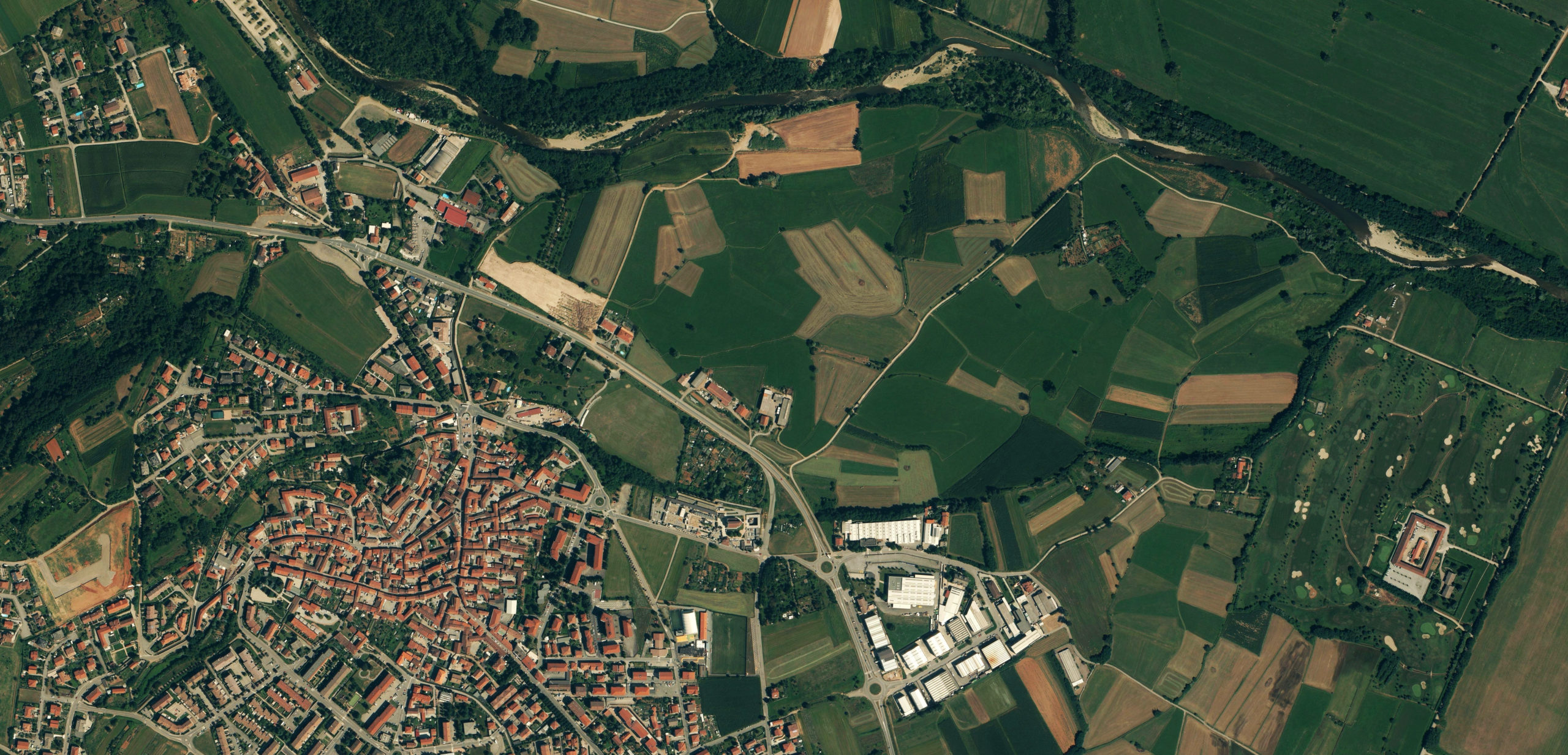Selecting an optical payload for a mission or service is an important decision. This article discusses some of the key factors that need to be considered when making this decision and was produced in collaboration with Simera Sense, a participant in the satsearch membership program.
Selecting any optical payload is challenging but selecting the right system for your mission or application is even more complicated. Many underestimate the complexity of the choices they can be faced when assessing the types of products on the market.
This article addresses nine important factors that a buyer needs to consider during the optical payload procurement process. The points discussed do not form an exhaustive list, but will hopefully make you aware of all the most critical parameters to take into account.
#1 The application
It can be easy for engineers to sometimes forget that they are developing an Earth Observation (EO) satellite for a specific application, solving real-world challenges. An optical payload is more than just a simple device taking beautiful pictures from outer space; it is a complex measurement system.
Optical payloads measure the energy reflected or emitted by an object on, or near, the Earth’s surface. And somewhere, someone uses this measurement by turning it into actionable information; providing vital insights to decision-makers.
Before selecting an optical payload, you need to understand what the end-user wants to achieve with the data and the level of insight that will be required from it. Hand in hand with this information, it is also essential to understand the error levels with which the end-user can live.
For example, it is vital to know the spectrum of crops the end-user needs to monitor, and how frequently, in precision agriculture. Furthermore, the geographical area covered, type of variations to measure, and confidence or error level are also necessary pieces of information. With these criteria understood, one can derive the optical payload’s spatial, spectral, radiometric, temporal, and operational requirements.
Another example is measuring economic activity within an area by counting various economic indicators, such as the number of cars parked within a business area, airplanes at an airport, ships in a harbor, and large trucks or infrastructure in an industrial zone. Here you need to know the size of the objects you want to count, the geographical distribution of these objects, how far they are apart, and whether you require accuracy of, for example, 80% or 99.9%.
#2 The size and volume
Although electronic and optical miniaturization has developed significantly in recent years, it is important to be realistic about the limits that still exist. You can’t expect the same performance from a 1kg and a 100kg optical payload.
The limitations that size and volume restraints impose are even more important for CubeSats. In a 3U, 6U, or even 16U CubeSat, everything works against you. Engineers shouldn’t expect miracles from their optical system – most satellites do have physical, thermal, and structural limits that can’t be exceeded.
The structures of nano- and microsatellites are “flimsy”, especially 12U and 16U structures, relative to their larger counterparts. In bigger satellites, one can modify the structure to accommodate a large payload with specific structural integrity requirements. In smaller satellites there is far less room to play with.

Optical payloads are delicate devices, and consist of optical elements polished to a fraction of a wavelength accuracy. Opto-mechanical engineers use state-of-the-art equipment to align these elements within arc seconds of each other. Therefore, the slightest thermal or mechanical instabilities may have massive impacts on optical performance.
Questions to ask:
- What is the resonant frequency of the payload and satellite bus? Are these frequencies adequately spaced, or will they excite each other?
- What are the thermal stability and thermal requirements of the payload? Can the satellite bus provide adequate thermal shielding and control?
#3 The aperture size and F-number
In optics, as with many things in life, size does matter; in this case, the effective aperture size.
Knowing the effective aperture size, one can quickly perform a couple of rule of thumb calculations to determine basic performance parameters. These parameters include spatial and radiometric resolution.
Ultimately, an optical system’s diffraction limit depends on the wavelength observed and the effective aperture diameter. Diffraction, due to physics, is a hard limit on a system’s performance, and it is therefore essential to understanding how close the manufacturer of the optical payload can get to the system’s theoretical limits, namely the diffraction limit.
For example, an optical payload flying at 500 km orbital height and operating in the 550 nm band has a GRD limit of 3.5 m if the aperture size is 95 mm. An equivalent system with an 80 mm aperture has a 4.2 m GRD limit. This is a 0.7 m GRD difference on a 15 mm aperture difference.
The same is valid for spatial cut-off frequency. In our example, the 95 mm aperture system’s cut-off frequency is about 300 cy/mm, while the 80 mm system has a 250 cy/mm cut-off. These parameters have a direct impact on the sharpness of fine detail within an image.
Similarly, the aperture size and F/# have an equivalent effect on the amount of light energy reaching the focal plane. The photography community is familiar with the F-stop principle where the lens halves the light intensity when going to the next F-stop, for example, F/5.6 to F/8. This is also true for optical payloads.
The biggest takeaway when using optical payloads on nanosatellites is that a slight difference in aperture can significantly impact performance. However, an increase in diameter and a decrease in F/# may also significantly impact the cost. Also, be aware of those using clever tricks to increase the aperture!
Questions to ask:
- What are the effective aperture size and F/# of the optical system? How do these impact the GRD and cut-off frequencies for my desired orbit and wavelength?
- Is the optical system limited by the diffraction of the aberrations within the system?
- Does the optical system make full use of the satellite’s available space to stretch the aperture to the limits?
#4 The Modulation Transfer Function
The figure of merit for spatial resolution is Modulation Transfer Function (MTF) and not Ground Sampling Distance (GSD), nor Ground Resolved Distance (GRD). Although the last two parameters play an important role, you need to compare apples with apples when selecting a payload.
First of all, one needs to understand that an imaging system’s Nyquist Frequency is directly related to the pixel size. By definition, the Nyquist Frequency is always 0.5 cycles per pixel, or two pixels are required to sample one cycle. Therefore, a system with 5.5 um pixels has a Nyquist frequency of 90,91 cy/mm. When evaluating MTF, one should do it at the Nyquist Frequency.

As part of your optical payload selection process, you need to determine an MTF “budget”. MTF factors to keep in mind are the optical MTF, the sensor aperture MTF, TDI and velocity mismatch, line-of-sight jitter, sensor diffusion, and sensor charge transfer efficiency. Atmospheric conditions can further deteriorate MTF but are outside the scope of this discussion.
Your choice of MTF depends on the application and the error margin with which the end-user can live. High-end systems requiring crisp images frequently aim for an end-to-end system MTF of above 20%, while the lower-end systems can accommodate system MTFs of as low as 8%.
Evaluating the overall MTF is also not that simple as a manufacturer can present the optical MTF in many forms and shapes:
- Frequently MTF is only shown as a function of spatial frequency. In this case, you need to make sure that the manufacturer gives the MTF at various field angles across the field, and not only on-axis.
- Another way to look at MTF is to plot the MTF against field angle at various spatial frequencies. A well-designed optical system maintains MTF at a specific spatial frequency across the field.
- Manufacturers frequently only plot the polychromatic MTF across the design spectrum of the optical system. When evaluating the MTF, you should compare monochromatic MTF plots as specific wavelengths at the various spatial frequencies.
- Last but not least, through-focus MTF at the various fields and wavelengths is also extremely important. Through-focus MTF indicates how sensitive the system is for focal shifts.
#5 The thermal environment
A large number of optical payloads can operate across a wide temperature range, and more can survive a broader temperature range. Unfortunately, this is where most people are making a mistake in optical payload procurement.
It is not about the temperature range, but rather about the gradients and difference across the payload, which influences the underlying optical performance parameters.
As explained earlier, optical payloads are highly sensitive to changes in the environment. Any relative movement between optical elements can result in a significant change in optical performance.
Payload engineers are forced to squeeze the best performance possible out of the available volume and mass budget. The result of this optimization process is that the system has excellent performance at a specific operating point. Deviations from this point result in significant performance drops.
From a thermal point of view, one should be sensitive to axial and radial temperature differences across the payload, as it may have the most significant impact on performance. Soak or ambient temperature differences may have a much lesser impact.
We all know that payloads use energy while capturing, storing, processing, and transmitting images. This energy is transformed into heat, and this heat needs to go somewhere. If you can’t dump the heat, the sensor’s temperature rises, directly impacting the system’s duty cycle. Meaning it shortens the time that one can use the payload per orbit.
Larger satellite platforms may have the ability to control the thermal environment, whereas nanosatellites do not have this capability. This limited ability to control the thermal environment makes the athermal design of the payload more critical.
When evaluating the thermal performance, the following information is essential:
- The payload’s duty cycle, or how long it takes for the sensor to reach maximum operating temperature, starting from ambient.
- With MTF as the figure-of-merit, the expected performance shift when experiencing an axial temperature difference of 3°C or more.
- With MTF as the figure-of-merit, the expected performance shift when experiencing a radial temperature difference of 3°C or more.

#6 The radiometric resolution
Radiometric resolution is maybe the least understood parameter when it comes to optical payloads. The main challenge is the vast amount of figures-of-merit and ways to calculate and express radiometric performance.
Here one thinks of Noise-Equivalent-Reflectance Difference (NE∆ρ) and Noise-Equivalent-Irradiance (NEI). Noise-Equivalent-Spectral-Radiance is also a helpful figure-of-merit for the reflective bands of multispectral and hyperspectral systems.
However, most payload manufacturers default to a plain Signal-to-Noise (SNR) ratio. This parameter is maybe the most challenging figure-of-merit to compare between systems as it is frequently quoted without any signal description: the conditions under which this number is valid.
Again, there are specific rules of thumb one can follow when evaluating radiometric performance. First of all, take a look at the pixel’s full well capacity, as this parameter gives you a good indication of the system’s photon noise limits. For example, if you operate a sensor with a well-capacity of 20,000 electrons near its limits, the SNR limit would be around 140 due to shot noise only. Then you still need to take all the other noise sources into account.
The next question is, how can you maximize the signal or photons captured and lower the noise. Maximizing signal, the manufacturer must optimize the signal throughput in optical transmission or increase the exposure time.
The satellite operator can increase exposure time by lowering the relative ground speed by applying Forward Motion Compensation (FMC). The sensor can also be exposed to more photons using a charge transfer Time Delay Integration (TDI) sensor. These sensors are expensive.
For lowering noise, digital Time Delay Integration options are available. This technique boils down to the averaging of the signal.
When evaluating SNR, the following information are essential:
- What radiance levels did the manufacturer use to calculate the SNR values?
- And, how well do these light levels correspond to your use case?
- Do different suppliers use the same radiance levels?
- What tricks-of-the-trade does the supplier use to increase the radiometric figure-of-merit?
- What limits or requirements do these tricks-of-the-trade put on the satellite bus?
#7 The spectral resolution
Earth Observation operators sometimes undervalue the spectral resolution of an optical payload. That said, the number and position of the spectral bands are highly dependent on the end application.
For example, if you only want to monitor and detect changes in physical structures on earth, three bands in the visible spectrum may be adequate. To monitor vegetation and detect slight changes in plant health, you may require up to seven bands.
When specifying spectral bands, the position and bandwidths are essential, directly impacting the radiometric resolution. Also, the manufacturer must align the cut-on and cut-off slopes of the bandpass filters with your requirements.
Hyperspectral solutions are trendy nowadays. A crucial question is how much value will this add to your data product, and will your end application benefit from these additional spectral bands?
Although more spectral bands are great, they increase the amount of data generated and decrease the area that can be covered.
#8 The data throughput
Current Earth Observation industry trends are well known; spatial and spectral resolution are increasing, meaning more data and pixels are processed, and satellites are getting smaller, resulting in increased complexity (and less power to transmit data).
Satellite operators would prefer to maximize spatial, spectral, and temporal resolution to achieve the highest return on investment. That said, optical payloads for nanosatellites can easily store up to 1 Tbit of data onboard, potentially even more.
So does this mean that the data throughput problem is solved?
Unfortunately, no. The most significant bottleneck is getting that data to the ground.
For example; imagine you need to download 1 Tbit of data daily and let us say you have access to 5 ground stations, 20 minutes per day for each ground station. To achieve the desired download capacity, you require a 200 Mbit/sec downlink. Maintaining this high throughput requires a lot of time and money. However, we do see a couple of cloud-based services addressing these operational challenges.
On the other hand, Earth Observation analysts claim that less than 5% of the data downloaded are used. If this is true, payload and satellite operators need to look at intelligent ways to download only the required data.
The following questions should be kept in mind when selecting an optical payload with efficient data handling capabilities:
- Are there any measures onboard the payload to increase data throughput?
- Are there ways to selectively download only the data required of areas of interest?
- Can one eliminate unwanted data, such as data with cloud cover?
- Can one add selective intelligence onboard the payload to minimize download time?
- Does the payload form part of a larger operational framework?

#9 budget and timeline
Optical payloads and satellites do cost money to produce, and the development takes time. These items are not a commodity and do not stand ready on the shelf for purchasing.
Although the NewSpace industry is trying to shorten the development process, it still takes a team of highly skilled people a finite amount of time to develop the end product.
To save money and time, stick to the standard offering as close as possible. Changing hardware interfaces or mounting points can significantly impact an optical payload.
Design modifications require additional simulations and environmental testing and can add up to a sizeable non-recurring engineering component.
This is also true for the electrical interfaces, as well as the command, control, and data interfaces. The fastest and most cost-effective option is to stay within the standard offerings.
If you require redundancy within the system, be prepared to pay the additional cost. In addition, it is important to note that optical components and sensors are expensive parts. Most companies won’t like to carry the risk of ordering high-cost components without a significant deposit.
For more information on Simera Sense please view their supplier hub here, or take a look at the company’s product portfolio for more details on the optical systems available on satsearch.
